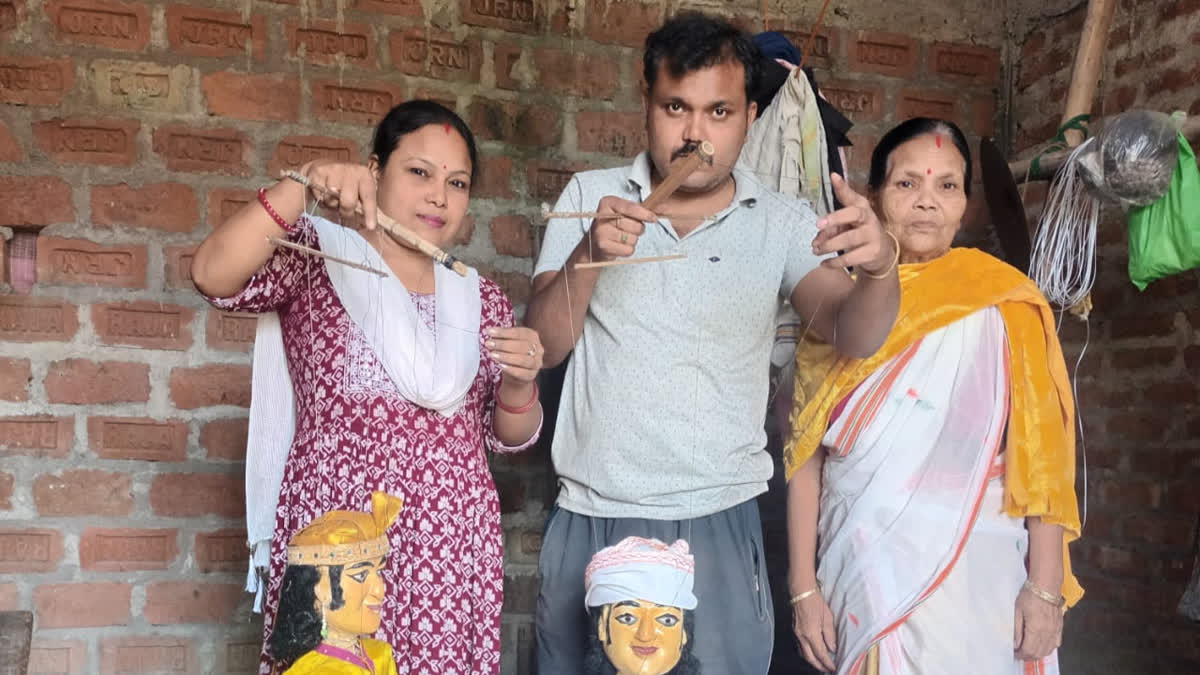Nagaon: Three decades ago, Giridhar Senapati was a busy person, attending various cultural events across the state. The owner of Nabaratna Puppet Theatre, Senapati now spends most days idle at his home in Bhalukmari village, Nagaon district, Assam. These days, he receives hardly two to three invites annually for puppetry performances or puppet theatre (called Putola theatre in Assamese).
The decreasing popularity of Putola Theatre has, however, not dampened the spirit of Senapati, whose entire family, including his wife, son, and daughter, is engaged in the traditional art form that dates back to the 9th century in Assam. Despite hardships, the Senapatis continue to practice Putola theatre to keep this heritage art form alive.
While the patriarch of the family Giridhar directs the whole theatre, his wife Padma makes the idols (Putola), their dresses and art other works. Senapati's son Rupon and daughter Jonmani normally pull the strings. All four also deliver dialogues and sing songs during the performance. Apart from Senapatis, there are also about 10 to 12 people, who accompany them during the puppetry show.
"I have been associated with Nabaratna Puppet Theatre for the last 40 years. Puppet Theatre used to be very popular in Assam till a few decades ago. However, it has lost its popularity due to different reasons. In Nagaon district alone there used to be six to seven theatre groups, who used to perform puppetry. However, most of them have already closed down. We are among a few groups, who have been surviving despite the hardships," said Giridhar Senapati.
According to experts, the history of Putola Nach or Puppet Theatre dates back to the 9th century. Although there is no documented record as to where and how puppetry started in Assam, the ancient scripture Kalika Purana has reference to puppetry performance in Assam. Kalika Purana is estimated to have been written between the 9th and 11th centuries, hence, experts guess that the art form dates back to as early as the 9th century in Assam.
"As per our knowledge, Vaishnav Saint and scholar Srimanta Sankardeva took the idea of a one-act play (Akankia nat) from Putola Nach or Puppet Theatre," said Senapati. He said while some people say that Putola Nach has originated in China, some opine that it originated in India only," he said.
"Putola Nach, or Puppet Theatre, has a rich heritage in Assam. Srimanta Sankardeva, the saint and scholar, who spread Neo-Vaishnavism in Assam, utilised various art forms, including one-act plays, to disseminate religious messages. He also employed puppetry and other artistic mediums to engage with the masses.
Unfortunately, there has been limited research on puppetry in Assam compared to the extensive studies conducted in some Western countries. Moreover, the artists involved in puppetry in Assam are often deprived of basic support, such as an artist pension.
As a significant part of Assam's folk culture, puppetry holds immense potential to convey messages of social change. There is much to be done by the government to promote and preserve this traditional art form," said Chandan Jyoti Bora, a journalist, who has conducted extensive research on puppetry in Assam.
The Nabaratna Puppetry Theatre normally stages different plays, which are based on epics like the Ramayana, and the Mahabharata, plays on the stories of Bhakta Prahlad and Raja Harischandra. "I think one reason why puppetry theatre has lost its popularity is lack of technology infusion. We have been performing puppetry in the traditional way. But, things are changing these days and we must infuse technology to upgrade the puppetry while keeping its soul intact and then I believe people will accept puppetry once again," said an optimistic Giridhar.
"We have learnt puppetry from our parents. Since we have seen the puppets from our childhood, we feel emotionally attached to the puppets as well as to the puppetry. I have been helping them. The problem is the financial constraints. My father received an artiste pension from the state government from last year," said Senapati's daughter Jonmani.
Jonmani, however, stressed the need to modernise the art form with proper technology infusion which is costly. "I believe if we can modernise the art form with technology, the present generation will also accept it and the old glorious days of puppetry theatre will come back soon," said Jonmani.



